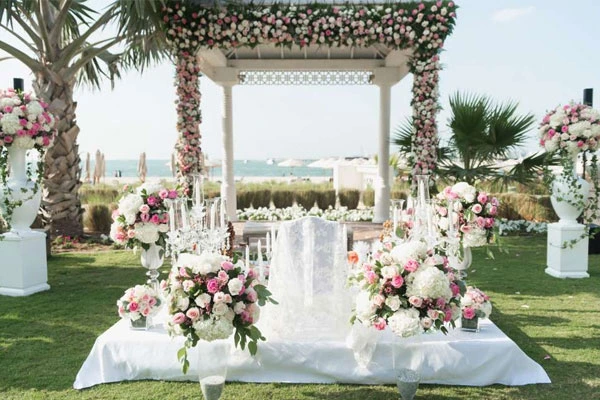One of the most enjoyable ceremonies that almost everyone experiences in their lives is the wedding celebration. This beautiful and sweet experience doesn’t come easily unless planned with the expertise and knowledge of professionals and companies that can provide necessary assistance and essential guidance to the couples. Ramarossi team, with its best and most beautiful engagement decorations, can set up a delightful Sofreh Aghd for you.
The term “Aghd” in Persian culture and language means tying a knot, securing, and making a covenant. The first wedding ceremony in which an engagement spread was set up dates back to the time of Alexander the Great, when he and many of his soldiers married Iranian women in the Zoroastrian style.
For the first time, the term “bride” was used in the Avestan literature during the Sassanian era, meaning white. Accordingly, at that time, the bride wore a white and embroidered dress, symbolizing its purity. The bride and groom would throw handfuls of flowers around each other.
The engagement spread is a table that is usually white or cream-colored and is spread out for the bride and groom. Specific and designated items are placed on it, including walnuts, almonds, hazelnuts, Nabat (sugar cone), rice, eggs, honey and isband (oleander), a mirror, a candlestick, and the Quran. All of these are essential items on the engagement spread, and they have been a tradition from ancient times, each carrying its own philosophy and meaning.
The history of the Iranian Sofreh Aghd
The Sofreh Aghd is one of the significant customs in Iranian culture and is used for wedding and engagement ceremonies. This custom, as an essential celebration in Iranian culture, plays a crucial role in wedding ceremonies. The history of the Iranian Sofreh Aghd dates back to ancient times and has various components, each representing specific symbols. Below is a brief overview of the history of the Iranian Sofreh Aghd:
Historical Background: The Iranian Sofreh Aghd dates back to ancient times in Iranian culture and is recognized as one of the most important ceremonies in wedding celebrations. In the past, this ceremony was held for the formal approval and announcement of marriage.
Components and Symbols: The Iranian Sofreh Aghd mainly includes elements such as heritage (jewelry and valuable family items), flowers (especially white and yellow symbolizing joy and maturity), treats (nuts and sweets), and candles (symbolizing light and brightness).
Celebration and Music: Engagement spread celebrations are usually accompanied by music and dance, with guests often dressed in formal attire, showcasing the ultimate representation of Iranian cultural display.
Spiritual Importance: The engagement spread, as a vital ceremony in marriage, is not only limited to celebration but also holds spiritual significance and represents family and social values.
Deep Cultural Significance in Iranian Weddings
The engagement spread holds deep cultural significance in Iranian weddings and is a symbolic representation of the values and aspirations associated with married life. The items carefully chosen for the spread carry profound meanings, and the ceremony itself plays a vital role in shaping the foundation of the couple’s life together.
Historical Significance:
The tradition of the Sofreh Aghd dates back to ancient times in Iranian culture and was considered one of the most crucial ceremonies in wedding celebrations. In the past, this ritual served as a formal announcement and approval of the marriage contract.
Symbolic Elements:
Each item on the Sofreh Aghd carries a unique symbolic meaning:
Mirror:
Reflecting beauty and purity in marital life, the mirror is a symbolic representation of the couple’s commitment to maintaining a clean and harmonious relationship.
Coins, Gold, and Silver:
Representing financial prosperity and economic stability, these items emphasize the couple’s mutual commitment to support each other in building a secure and comfortable life.
Fruits:
Symbolizing fertility, abundance, and the hope for a fruitful life together, fruits are a representation of the couple’s shared aspirations for a prosperous family.
Candle and Candlestick:
The light of the candle symbolizes hope, enlightenment, and the brightness that marriage brings into one’s life.
Sweets and Treats:
Representing the sweetness of life, the inclusion of sweets signifies the wish for a joyous and pleasant journey throughout the couple’s married life.
Kaleh Ghand (Sugar Cone):
The tradition of rubbing sugar cones on the couple’s heads signifies the showering of sweetness and joy in their lives.
Musical and Festive Atmosphere:
Engagement spread ceremonies are often accompanied by lively music, dancing, and guests donning formal attire. This festive atmosphere adds to the cultural richness of the event, showcasing the vibrant and celebratory nature of Iranian weddings.
Spiritual Importance:
The presence of the Quran on the Sofreh Aghd brings a spiritual dimension to the ceremony, emphasizing the sacred commitment of marriage. This inclusion reflects the religious values deeply embedded in Iranian culture.
Continuing Traditions:
Over time, the Sofreh Aghd has evolved while preserving its essential elements. It continues to be a central part of Iranian weddings, connecting modern couples with their cultural heritage and fostering a sense of continuity and tradition.
In conclusion, the Sofreh Aghd is a cherished tradition that not only celebrates the union of two individuals but also embodies the cultural, spiritual, and symbolic richness of Iranian weddings. Through this ceremony, couples embark on their marital journey with the blessings of tradition, symbolizing a commitment to a life filled with love, prosperity, and joy.
These items may vary based on the region and personal preferences. Additionally, some items might be added or excluded from this list. In this regard, Ramarossi team offers the best, most beautiful, and exquisite engagement spreads tailored to your preferences.
FAQs
Does the Aghd ceremony in Iranian culture have specific elements?
Yes, the Aghd ceremony in Iranian culture involves various elements, and it is commonly referred to as “Sofreh Aghd” or the Aghd table. This table is beautifully decorated and includes symbolic items representing different aspects of the couple’s life.
What items are typically present on the Sofreh Aghd?
The Sofreh Aghd includes items such as the Quran (as a religious symbol), a mirror and candlesticks (symbolizing brightness and light in married life), sweets, fruits, coins, decorated eggs, a tray of wild rue seeds, honey, and more. Each item carries a specific symbolic meaning.
What is the significance of the mirror and candlesticks on the Sofreh Aghd?
The mirror and candlesticks represent brightness and illumination in the couple’s life. The mirror reflects the couple’s future together, while the candlesticks symbolize the light of their shared path in married life.
Why are decorated eggs and wild rue seeds included in the Sofreh Aghd?
Decorated eggs symbolize fertility and a prosperous life. Wild rue seeds, known as “Esphand,” are believed to ward off evil spirits and bring protection and positivity to the couple’s life.
Are the elements on the Sofreh Aghd the same across all regions and families?
While there are common elements, variations may exist based on regional customs and personal preferences. Some families may add or omit certain items, making each Sofreh Aghd unique to the couple’s background and traditions.


